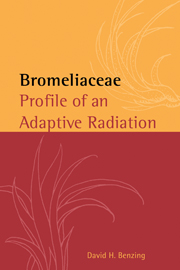Book contents
- Frontmatter
- Contents
- List of contributors
- Preface
- Acknowledgments
- Glossary
- Abbreviations
- Part one Brief overview
- Part two Basic structure, function, ecology and evolution
- 2 Vegetative structure
- 3 Reproductive structure
- 4 Carbon and water balance
- 5 Mineral nutrition
- 6 Reproduction and life history
- 7 Ecology
- 8 Relationships with fauna
- 9 History and evolution
- Part three Special topics
- Literature cited
- Name index
- Subject index
- Taxon index
3 - Reproductive structure
from Part two - Basic structure, function, ecology and evolution
Published online by Cambridge University Press: 19 January 2010
- Frontmatter
- Contents
- List of contributors
- Preface
- Acknowledgments
- Glossary
- Abbreviations
- Part one Brief overview
- Part two Basic structure, function, ecology and evolution
- 2 Vegetative structure
- 3 Reproductive structure
- 4 Carbon and water balance
- 5 Mineral nutrition
- 6 Reproduction and life history
- 7 Ecology
- 8 Relationships with fauna
- 9 History and evolution
- Part three Special topics
- Literature cited
- Name index
- Subject index
- Taxon index
Summary
A substantial literature dating back more than a century describes the bromeliad reproductive apparatus. Taxonomists working with dried specimens authored most of the early treatments. Interest continues, but specimen quality has improved allowing analyses to be more comprehensive. For example, Brown and Terry (1992) used liquid-preserved flowers and scanning electron microscopy to determine that the delicate petal scale that figures so prominently in the most recent monograph of the family (Smith and Downs 1974, 1977, 1979; Fig. 3.1) circumscribes some genera more convincingly than others. Wet material has also permitted determinations of when certain features appear during ontogeny, and accordingly, their utility for distinguishing taxa of low vs. higher rank.
Plant form underlying reproductive phenomena like pollination and seed dispersal and the genetic structure of populations are our primary concern for this review. Unfortunately, few of the hundreds of publications devoted to the reproductive apparatus of Bromeliaceae provide much insight on any of these subjects. Moreover, inquiry on flowers, fruits and seeds continues to be motivated primarily by interests in systematics. The exceptional report that does depart from tradition usually addresses the same question, namely who pollinates which bromeliad?
Today, molecular biology is augmenting the morphological data traditionally used to infer bromeliad history. However, cladograms based on nucleotide sequences must be more fully resolved than those illustrated in Chapter 9 to produce the phylogeny necessary to determine where, when and how often decisive features of the reproductive apparatus evolved.
- Type
- Chapter
- Information
- BromeliaceaeProfile of an Adaptive Radiation, pp. 79 - 106Publisher: Cambridge University PressPrint publication year: 2000
- 1
- Cited by



